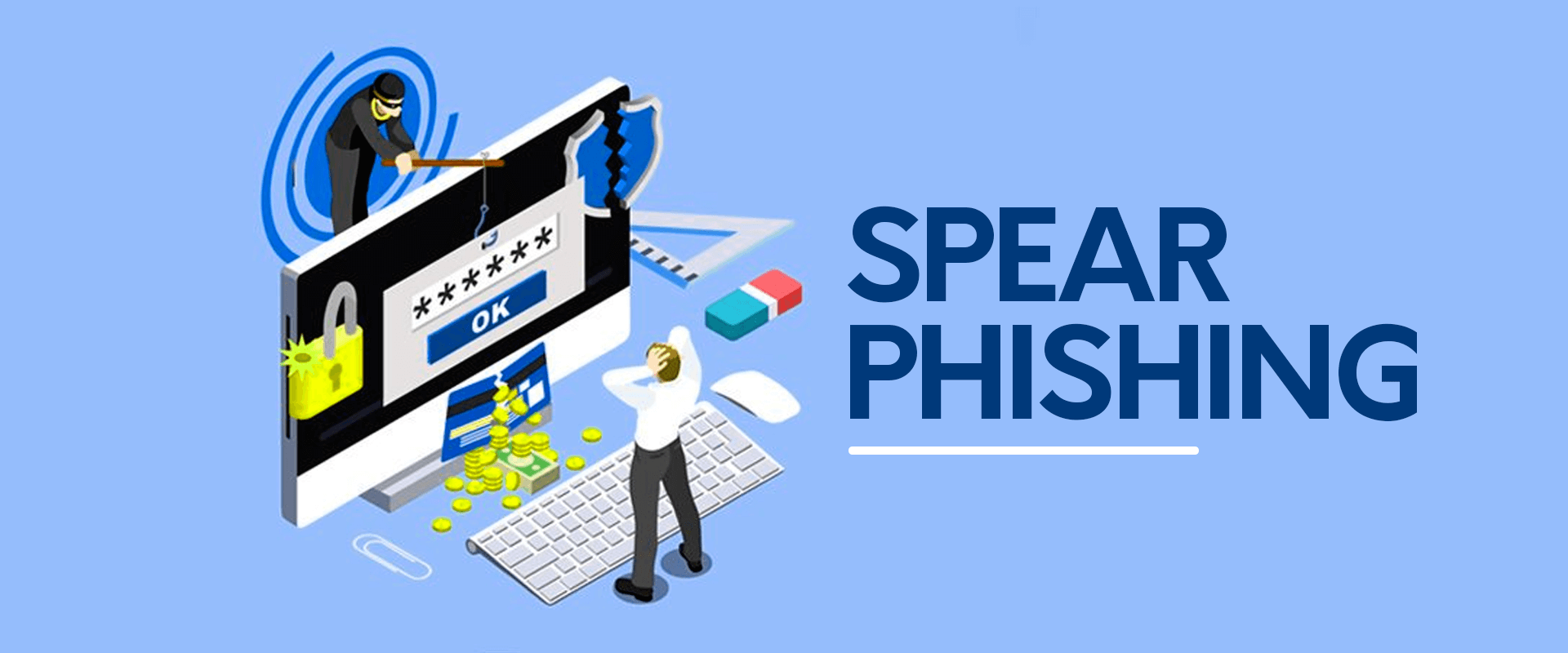Keeping your small to mid-sized business cyber secure is becoming increasingly difficult. Cyber threats are no longer the work of lone hackers in a basement. Instead, sophisticated cybercriminal networks, nation-states, and organized groups employ professionals whose sole focus is to breach your systems. One of the most common ways they do so is through a targeted cyberattack known as spear phishing. They use social engineering to exploit human trust and trick individuals into downloading malware and revealing sensitive information. This blog will explore common examples of spear phishing attacks, ways to identify these attacks, and prevention strategies.
What is a Spear Phishing Attack?
Spear phishing is a cybercrime that carries out targeted attacks against individuals and businesses using their email. Criminals use savvy tactics to gather personal data about their targets and send emails that sound familiar and trustworthy.
These emails usually contain attachments containing malicious links to ransomware, malware, or spyware. Additionally, they blatantly ask the recipient to respond urgently, like sending personal data such as a banking password or transferring a specific sum of money.
In cases of Spear Phishing, victims mistakenly believe they know the sender and trust them because the emails are written in an extremely familiar tone and refer to personal information about the recipient.
And that’s why common, unaware folks end by responding to the request.
Spear phishing vs. Phishing vs. Whaling
Phishing and spear phishing serve similar illicit purposes, even though spear phishing attacks target many more people. While spear phishing emails are sent to a select group or an individual, phishing emails target a large group of people.
By limiting the targets, the spear phisher can include personal information such as the target’s first name, financial documents, or job title, making the malicious emails seem trustworthy.
Whaling
Whaling attacks use the same personalized technique. A whaling attack is a spear phishing attack administered at high-profile targets, such as politicians, C-level executives, or celebrities.
Sometimes, customized whaling attacks can also target and use email spoofing, social engineering, and content spoofing methods to access fragile data.
How does a Spear-Phishing Attack work?
Here are the key steps involved in a spear phishing attack:
- Research and Targeting: The attacker identifies a specific target, often someone with access to sensitive information, and gathers personal details about them, like their job title, recent news, or interests, through online research on social media or other public platforms.
- Crafting the Message: Using the gathered information, the attacker creates a tailored email or message that appears to be from a trusted source, often mimicking the style and format of legitimate communication from their company or colleagues.
- Social Engineering Techniques: The message may include urgency, fear tactics, or flattery to manipulate the target into taking action quickly.
- Delivery: The attacker sends the crafted message to the target, making it seem like a legitimate communication, potentially including a malicious link or attachment.
- Exploiting the Victim: If the target clicks on the link or the attachment, they may be redirected to a phishing website, download malware, or unknowingly reveal sensitive information.
Spear Phishing Examples
Here are some notable spear phishing examples:
- John Podesta Email Hack (2016): John Podesta, chairman of Hillary Clinton’s 2016 presidential campaign, fell victim to a spear phishing email disguised as a security alert. This led to the compromise and public release of thousands of confidential emails, influencing the U.S. political landscape.
- Mattel Payment Fraud Scam (2015): Attackers impersonated Mattel’s CEO, instructing a finance executive to wire over 3 million to a fraudulent account in China. The company recovered the funds, but the incident underscored the effectiveness of well-crafted spear phishing emails.
- Target Data Breach (2013): Cybercriminals targeted a third-party HVAC contractor with a spear phishing email, gaining access to Target’s network. This breach resulted in credit and debit card information being stolen from approximately 40 million customers, highlighting vulnerabilities in supply chain security.
- FACC AG Cyber Heist (2016): Austrian aerospace firm FACC AG suffered a loss of 42 million euros when attackers used spear phishing to deceive employees into transferring funds.The CEO and CFO were dismissed as a result of the event.
- RSA Security Breach (2011): Employees at RSA received spear phishing emails containing malicious attachments. Once opened, these allowed attackers to steal data related to RSA’s SecurID two-factor authentication products, compromising security for numerous clients.
What Makes Spear Phishing So Dangerous?
Here are the key reasons why spear phishing attacks are so dangerous.
- Highly Personalized: Attackers gather detailed personal information about their target, like their job role, recent company news, or even personal interests, to create a very convincing email.
- High Success Rate: Due to the personalized nature of the attack, spear phishing emails are more likely to be opened by the target compared to generic phishing attempts.
- Access to Sensitive Data: Since the target is often someone with access to critical information, a successful spear phishing attack can result in significant data breaches.
- Potential for Significant Consequences: A successful spear phishing attack can result in stolen credentials, financial losses, data breaches, and disruption to business operations.
- Credibility Through Social Engineering: In order to gain the victim’s trust, the attacker employs social engineering techniques, making them more likely to click on a link or open an attachment without suspicion.
- Targeted at High-Value Individuals: Often, spear phishing attacks target executives or individuals with access to sensitive data within an organization, maximizing potential damage.
- Difficult to Detect: Because the emails are so personalized, they can easily bypass traditional spam filters and appear legitimate to the recipient.
4 Ways to Identify Spear Phishing Attacks
Ways to identify a spear phishing attack include:
- Inspecting the Subject Line
You can find one of spear phishing attempts’ biggest giveaways within the subject line. The majority of the time, the subject lines attempt to bait people with a sense of familiarity or terms of urgency.
The five most often used subjects in spear phishing emails:
- Are you available (10%)
- Payment status (5%)
- Request (36%)
- Follow-up (14%)
- Urgent or Important (12%)
All these terms express some sense of familiarity, and some even go as far as using “Re:” or “Fwd:” making it appear as though it is part of a previous conversation.
- Check the Email Sender
One of the most frequent forms of spear phishing attacks is impersonation. Therefore, the most used spear phishing tactic is creating a website with a domain name replicating a well-known organization. Generally, letters are misused to fool unsuspecting users, and websites are completely identical to the actual site.
- Message Content
A spear-phishing email mainly consists of your personal information, like contact addresses, pets’ names, phone numbers, or practically anything relating to you that you wouldn’t think anyone could find online.
Attackers often opt to play the long game with sophisticated targeted emails to build relationships with their victims and gain trust.
- Links and Attachments
Many attachments in spear phishing emails include embedded malware or forms where you must enter your most sensitive information. Malware generally comes in the form of a .exe file, .zip files, PDF, Word, or Excel documents.
You can check the validity of attachments by looking at where the email came from easily by hovering your mouse over the ‘from’ address. Using images instead of text is one of the latest techniques hackers use to avoid detection from protection and security software.
Spear Phishing Attacks: Prevention & Mitigation
Here are key ways to prevent and mitigate spear phishing attacks:
- Employee Security Awareness Training: Regularly train employees to recognize the signs of phishing emails, including suspicious senders, unusual urgency, and suspicious links, and to verify information before clicking or providing sensitive details.
- Email Security Filters: Use advanced email filtering systems that can identify and block phishing attempts based on suspicious content, sender addresses, and malicious links.
- Suspicious Email Reporting: In addition to filtering emails, you should encourage employees to report any suspicious emails to the IT department immediately.
- Multi-Factor Authentication (MFA): Enable MFA across all critical accounts to fortify security measures, even if a password is compromised.
- Strong Password Policies: Enforce strong password requirements, including length, complexity, and prohibiting password reuse.
- Regular Security Updates: Update all operating systems and applications with the most recent security updates to fix vulnerabilities.
- DMARC Implementation: Use Domain-based Message Authentication, Reporting & Conformance (DMARC) to stop email spoofing and enhance email legitimacy.
- URL Filtering: Implement URL filtering to block access to malicious websites linked in phishing emails.
- Data Protection: Limit access to sensitive data to minimize potential damage from a breach.
- Incident Response Plan: Develop a well-defined incident response plan to quickly identify, contain, and remediate a spear phishing attack if it occurs.
- Investigate Unusual Activity: Monitor user activity for unusual login attempts or suspicious data access patterns to identify potential compromises.
- Post-Incident Analysis: After a spear phishing incident, conduct an analysis to understand the attack vector and implement necessary security improvements.
Conclusion
Spear phishing attacks remain a major threat to businesses, exploiting trust and personalization to steal sensitive data. You need a proactive approach to safeguard your organization from these sophisticated cyber threats. Imagine IT, one of the leading cyber security solution providers, offers comprehensive protection against phishing attacks through advanced threat detection, employee training, and multi-layered security protocols. Our expertise in spear phishing in cyber security helps businesses prevent unauthorized access, ensuring data remains secure.
We are a trusted managed service provider in Wichita, Garden City, Sterling, Zeeland, and Bloomington, delivering tailored cybersecurity solutions that fit the needs of small and mid-sized businesses. From real-time threat monitoring to phishing awareness training, our end-to-end approach minimizes risks and strengthens your organization’s defenses. Don’t let a spear phishing attack compromise your business. Contact Imagine IT today to build a resilient security strategy that protects your data, employees, and reputation.





